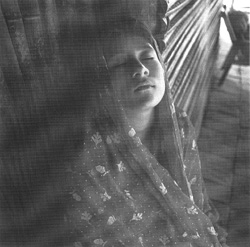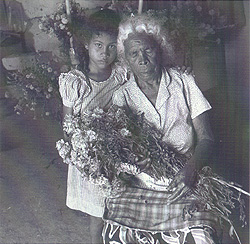Africa's Legacy in
Mexico
|

"Virgin of the Canes," Corralero, Oaxaca, Mexico, 1987
WHAT IS A MEXICAN?
Miriam Jimenez Roman
Black people in Mexico? The looks of amazement
and disbelief on the faces of first-time viewers of Tony Gleaton's photographs
are eloquent testimony to the significance of these images. Particularly
to those who have little or no knowledge about societies beyond the borders
of the United States, these photographs are a revelation. They force us
to rethink many of our preconceptions not only about our southern neighbor
but more generally about issues such as race, ethnicity, culture, and national
identity.
Not long ago, on a hot and humid July day, I rode with friends to the
town of Yanga, in the state of Veracruz on Mexico's gulf coast. In recent
years, Yanga has received considerable attention as one of the Americas'
earliest "maroon communities": settlements founded by fugitive
slaves. Originally known as San Lorenzo de los Negros, in 1932 the town
was renamed for its founder, a rebellious Muslim man from what is now Nigeria.
In 1609, after resisting recapture for 38 years, Yanga negotiated with the
Spaniards to establish a free black community.

"Embrace of Memory," Cuajinicuilapa, Mexico, 1990
Today a recently erected statue of Yanga stands on the outskirts of the town, more a testimony to the persistence of a few Mexican anthropologists who "re-discovered" the place than to the historical memory of its founders' descendants. For as I strolled through the area and talked to the residents, and saw the evidence of an African past in their faces, I discovered that they have little more than amused curiosity about the outsiders who express interest in that past. Yanga's people have quite simply been living their lives as they always have, making the adjustments necessary in a changing world and giving little thought to an aspect of their history for which they are now being celebrated.
The story of Yanga and his followers is remarkable for being so typical: The town's relative isolation is the reason for its founding and for its continued existence as a predominately black enclave. Fugitive slave communities were commonly established in difficult-to-reach areas in order to secure their inhabitants from recapture.
But their physical isolation has also led to their being ignored. Particularly since the Revolution (1910-29), the Yangas of Mexico--most found dispersed throughout the states of Veracruz on the gulf coast and Oaxaca and Guerrero south of Acapulco--have been out of sight and out of mind, generally considered unworthy of any special attention. (1, 2) Mexico's African presence has been relegated to an obscured slave past, pushed aside in the interest of a national identity based on a mixture of indigenous and European cultural mestizaje. In practice, this ideology of "racial democracy" favors the European presence; too often the nation's glorious indigenous past is reduced to folklore and ceremonial showcasing. But the handling of the African "third root" is even more dismissive. For all intents and purposes the biological, cultural, and material contributions of more than 200,000 (3) Africans and their descendants to the formation of Mexican society do not figure in the equation at all. Because they live as their neighbors live, carry out the same work, eat the same foods, and make the same music, it is assumed that blacks have assimilated into "Mexican" society. The truth of the matter is, they are Mexican society. The historical record offers compelling evidence that Africans and their descendants contributed enormously to the very formation of Mexican culture.
When Yanga and his followers founded their settlement , the population of Mexico City consisted of approximately 36,000 Africans, 116,000 persons of African ancestry, and only 14,000 (4) Europeans. Escaped slaves added to the overwhelming numbers in the cities, establishing communities in Oaxaca as early as 1523. Beyond their physical presence, Africans and their descendants interacted with indigenous and European peoples in forging nearly every aspect of society. Indeed, the states of Guerrero and Morelos bear the names of two men of African ancestry, heroes of the war of independence that made possible the founding of the republic of Mexico in 1821.
It is within this context that we must view Tony Gleaton's photographs. The people in these images, ignored in the past, now run the risk of being exoticized, of being brought forward to applaud their "Africanness" while ignoring their "Mexicanness." The faces of these children and grandmothers should remind us of the generations that preceded them. But we must not relegate them to history. As always, they remain active participants in their world. To understand the implications of the people of Yanga--and of Cuajinicuilapa, El Ciruelo, Corralero, and other like communities--we must go beyond physical appearance, cease determining the extent of Africa's influence simply by how much one "looks" African, and go forward to critically examine what indeed is Mexico and who are the Mexicans.
So, yes, there are black people in Mexico. We may marvel at these relatively
isolated communities that can still be found along the Pacific and gulf
coasts. But of greater significance is recognizing the myriad forms that
mark the African presence in Mexican culture, past and present, many of
which remain to be discovered by people such as Tony Gleaton and ourselves
and certainly by the Mexican people.
Notes
1. There are notable exceptions to this lack of attention. The anthropologist Gonzalo Aguirre Beltran's seminal works ("La Poblacion Negra de Mexico, 1519-1810." Mexico: Ediciones Fuente Cultural, 1946; and "Cuijla: Esbozo Etnografico de un Pueblo Negro." Veracruz, Mexico: Universidad Veracruzana, 1989) remain among the most important on the subject. Doubtless influenced by the interest in Africans and their descendants in other parts of the world, during the past decade a small but significant group of Mexican intellectuals have begun focusing on black Mexicans. Back
2. It is true that the state of Veracruz (and especially the port city of the same name) is generally recognized as having "black" people. In fact, there is a widespread tendency to identify all Mexicans who have distinctively "black" features as coming from Veracruz. In addition to its relatively well-known history as a major slave port, Veracruz received significant numbers of descendants of Africa from Haiti and Cuba during the latter nineteenth and early twentieth centuries. Back
3. It is impossible to arrive at precise figures on the volume of enslaved Africans brought to Mexico or the rest of the Americas. Hungry for slaves and eager to avoid payment of duties, traders and buyers often resorted to smuggling. The 200,000 figure is generally recognized as a conservative estimate. Back
4. The source of these figures is the census of 1646 of Mexico City, as reported by Gonzalo Aguirre Beltran in "La Poblacion Negra de Mexico" (p. 237). These approximate figures include as persons of African ancestry only those designated as "Afromestizos," in accordance with the caste-system definitions at the time. The census indicates that there were also more than a million indigenous peoples. In fact, such precise definitions were almost impossible to make, and it is highly probable that the categories "Euromestizos" and "Indomestizos" also included persons of African descent. Back